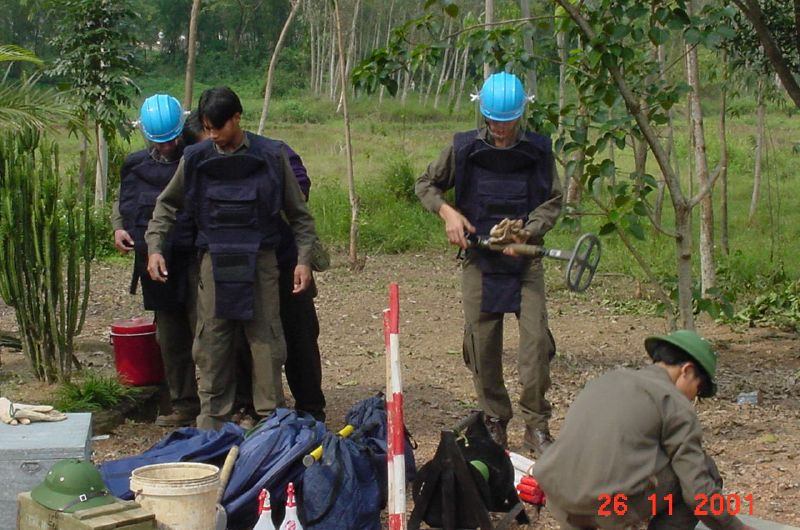 Clearing an area of landmines in Vietnam. EOD 12 Team Prep. November 26, 2001. Wikimedia Commons/James Hathaway
Clearing an area of landmines in Vietnam. EOD 12 Team Prep. November 26, 2001. Wikimedia Commons/James Hathaway In recent years, the world’s enthusiasm for new technology has been accompanied by growing concern over the harmful social, environmental, and economic impacts of these same technologies. In response to what is often referred to as a “techlash” [1], a new focus on “tech for good” can be found in the private sector as well as in higher education and the realm of governments. For example, Communitech, an organization dedicated to supporting tech startups in the region of Waterloo, ON, Canada, rebranded its annual tech summit around the theme of tech for good in 2018 [2]. This included the development and launch of the Canadian Tech for Good Declaration, an effort to build the commitment of companies to a set of six principles, including things like “leave no one behind” and “think inclusively at every stage” [3].
This was just one of literally dozens of declarations and manifestos that have appeared in recent years, and, beyond words and conferences, there has also been a proliferation of tech for good initiatives and organizations, many of which aim to contextualize what is meant by the expression. Questions that have been wrestled with include: How should we define what is good? Who gets to define it? And, perhaps most importantly, how do we achieve it?
The operating definition of PeaceTech is “the movement to use technology to end violent conflict and extremism.”
One of the busiest clusters of initiatives falls under the “AI for Good” or “Data for Good” rubric, as evident, for example, in the IEEE Global Initiative on Ethics of Autonomous and Intelligent Systems [4]. Another cluster of organizations can be grouped under what is sometimes referred to as Civic Tech [5] or Public Interest Technology [6]. And there is a longstanding and significant effort to apply technology to sustainability challenges; numerous projects and organizations that make up the Green Tech or Clean Tech movement can also be thought of as examples of tech for good. It is within this larger context of efforts to make “tech for good” more specific and concrete that PeaceTech should be situated.
PeaceTech refers to a broad range of activities found at the intersection of peace and technology, and the term was first introduced with the creation of the PeaceTech Lab, Washington, DC, USA, in 2008. Affiliated with the U.S. Institute of Peace, the lab became an independent nonprofit in 2014. The operating definition of PeaceTech is “the movement to use technology to end violent conflict and extremism” [7]. As evident in the kinds of projects the PeaceTech Lab has sparked, this includes tools to disrupt violence, as well as tools to respond to the root causes of conflict by addressing systemic injustices and restoring relationships so that a sustainable and positive peace becomes possible.
Beyond the PeaceTech Lab, another key node of activity can be found at the Peace Innovation Institute, based in The Hague and affiliated with the Peace Innovation Lab, Stanford University [8]. In the Canadian context, Conrad Grebel University College at the University of Waterloo has supported PeaceTech efforts through the Kindred Credit Union Centre for Peace Advancement since 2014. In addition to seeking to leverage technological expertise to augment the advancement of peace, the Centre seeks to leverage insights from the field of peacebuilding to critically engage developments in technology.
More concretely, Centre for Peace Advancement participants has included a wide range of PeaceTech startups, including a venture developing hardware to make the clearance of landmines and other unexploded ordinances faster and safer [9], and a venture developing software that enables organizations to implement and grow diversity, equity, and inclusion initiatives [10]. The Centre is also home to peace researchers focused on the military and security implications of emerging technologies such as lethal autonomous weapons systems [11]. And students in the PeaceTech Living Learning Community have been equipped to use technology to create positive change as both professionals and engaged citizens [12].
Coming at the intersection of peace and technology from both a critical and a constructive direction resonates with the emergence of “digital peacebuilding” as a specialization within the field of peacebuilding theory and practice. Indeed, the expression “digital peacebuilding” is sometimes used interchangeably with PeaceTech. As noted at a consultation cohosted by the PeaceTech Lab in 2020, it typically connotes a broad nexus that includes more than simply the use or application of digital technologies by peacebuilders [13]. Digital peacebuilding also includes addressing emerging threats caused by digital technologies, including cyberwarfare tactics aimed at undermining democracy, or hate speech on social media that drives greater polarization. Since this consultation, New York University’s Centre on International Cooperation has completed an ecosystem mapping project focused on the uses of data for peacebuilding and prevention [14].
Given that the challenges to peace appear to be growing at all levels, should the practitioners and promoters of PeaceTech remain content to fill an interesting niche in the broader tech for good movement? Perhaps, it is time to make peacebuilding a central pillar.
Paul Heidebrecht is the inaugural director of the Kindred Credit Union Centre for Peace Advancement and an adjunct assistant professor of peace and conflict studies at Conrad Grebel University College, Waterloo, ON, N2L 3G6, Canada, and the University of Waterloo, Waterloo , ON, N2L 3G1, Canada. Email: heidebrecht@uwaterloo.ca.
_____
To view the full version of this article including references, click HERE.
_____






 JOIN SSIT
JOIN SSIT